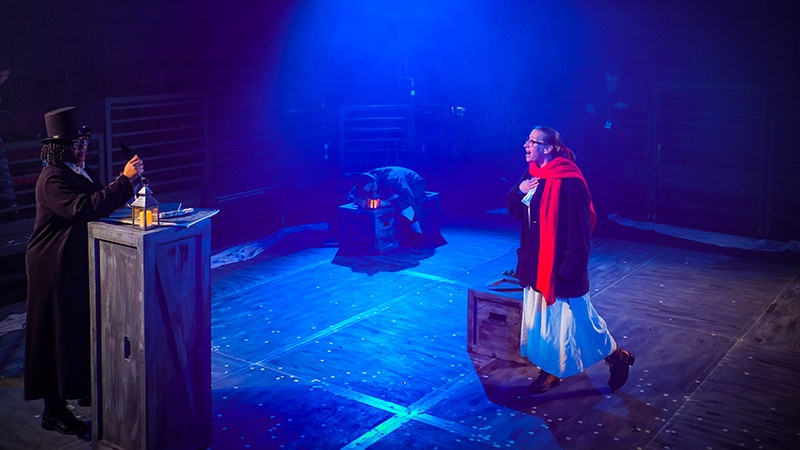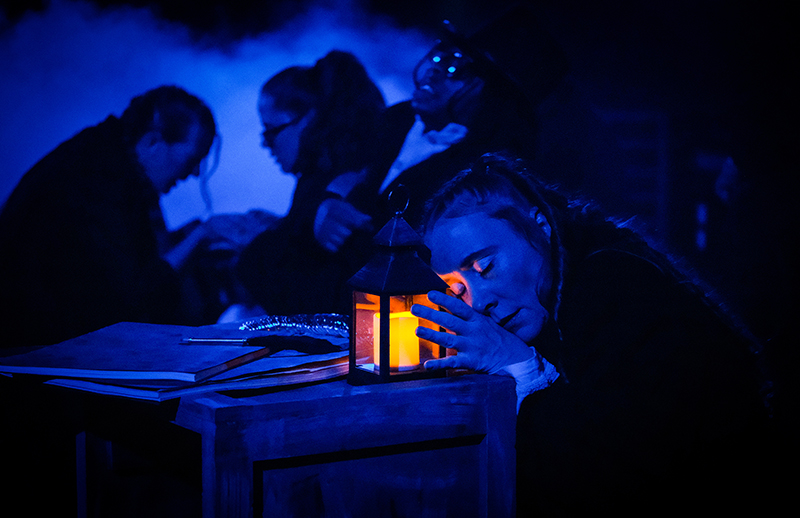
Denise Presson, right, played the role of Bob Cratchit in a recent rehearsal of “A Christmas Carol.” Rehearsal photos by Joe Mahoney/Special to The Colorado Trust
Denise Presson, right, played the role of Bob Cratchit in a recent rehearsal of “A Christmas Carol.” Rehearsal photos by Joe Mahoney/Special to The Colorado Trust
Denise Presson has taken the character of Bob Cratchit to heart.
Presson, 39, played the role of the kindly family man in a recent, all-female stage production of Charles Dickens’ “A Christmas Carol” in Denver. Cratchit, Ebenezer Scrooge’s exploited employee, radiates a humble selflessness and devotion to family that resonated with Presson.
“I love being a character who is always hopeful, who people actually care about, and who cares about other people,” Presson said.
That kind of mutual caring has been in short supply for the past 10 years of Presson’s life. She has spent those years as an inmate at the Denver Women’s Correctional Facility, serving a 42-year sentence for second-degree murder. She’s eligible for parole in 2038.
Her daughter, now 13, was two years old when Presson was sent away.
In fact, the entire cast and crew of “A Christmas Carol” were inmates at the prison. In early December, they staged two performances in the facility’s gym, and two at the Newman Center at the University of Denver (DU)—a decidedly more upscale venue.
“A Christmas Carol” was the second stage show produced by the University of Denver Prison Arts Initiative, a program launched in 2017 by DU Assistant Professor Ashley Hamilton. The first was “One Flew Over the Cuckoo’s Nest,” an all-male production featuring inmates at the Sterling Correctional Facility in September.
The prison arts program provides a variety of arts and other opportunities to inmates in prisons across Colorado, including publishing a newspaper, creative writing, podcasting, family events and a group leadership workshop. The goal, according to the program’s website, is “empowering individuals to improve the quality of their lives and prepare to make positive changes in their communities upon release.”
It’s based closely on a similar program, Rehabilitation Through the Arts, that Hamilton and her husband, Clare Hammoor, were involved with in New York before moving to Denver three years ago. (Hammoor directed “A Christmas Carol” from a script he adapted from the novel.)
The redemptive message of “A Christmas Carol” carries special resonance in this context. Presson said inhabiting a character allowed her to let down her guard and be herself for the first time in years.
“You have to act your way through prison,” she said. “Acting like you’re someone you’re not keeps you safe and people at a distance. You put up these walls you wouldn’t if you were at home in a safe space. So my pre-acting gig was being incarcerated. Now I get to act on a stage.”

Being part of the theater troupe builds self-confidence and a sense of camaraderie that expands beyond the actresses and into the broader prison population. “I feel like it affects the whole place in a positive way,” said Patrice Pullie, who played the Ghost of Christmas Present. Pullie has been confined to the women’s prison for the past year, on auto theft and drug charges. She said she has been in and out of prison since 1996.
“People acknowledge us and congratulate us, and the interesting thing is even people not in the play are being nicer to each other,” she said.
Warden Ryan Long has observed the same phenomenon at the 1,008-inmate women’s prison he oversees.
“The energy around the program and its reception from the women’s peers and staff alike is helping shift the philosophy and the conceptual way we approach corrections,” Long said.
Dean Williams, who has headed the state Department of Corrections since January 2019, refers to this shift as “the normalization of prison.” He said there is no reason prisons have to be cold, sterile, punitive environments. Simple acts like planting trees and creating green spaces make a significant difference to inmates facing long sentences. Creating more opportunities for family visitation and bringing in programs like the Prison Arts Initiative have a big impact as well, he said.
“Many people who are incarcerated—not all, but many—are looking for redemptive opportunities and to have meaning back in their lives,” Williams said. “We are providing a purpose again, a reason for these inmates to get up in the morning. It makes prison safer for inmates and staff alike.”
Williams said his department has launched a variety of new programs aimed at normalizing prison. Some initiatives bring male and female inmates together. Under another, 21 male inmates with less than a year left in their sentences are working prevailing-wage jobs for a company in Sterling.
“Theater is just one of the things we’re doing. It just happens to be a really cool one,” he said. “I like to say that we’re changing the prison system one theater production at a time.”
Arts and theater programs in prison are more than just warm and fuzzy, feel-good efforts. If incarceration is at least in part about rehabilitation and not just punishment, then such programs are a step in the right direction. Social science research over several decades leaves little doubt: programs like DU’s have a positive impact on prison culture, on inmates, and on recidivism rates.
A 2014 annotated bibliography of prison arts academic research studies points out that arts and education programs in prisons have existed for decades, but have actually been in decline over the past 25 years.
“Pell grants for inmates were eliminated in 1994, virtually removing the reformative degree-granting presence of community colleges and universities from the prison system,” authors wrote in the bibliography’s introduction. “This, along with the growth in private prisons, which had no rationale for providing arts or educational programs, has resulted in the reduction of prison arts programs across the U.S.”
There’s a compelling case to be made for programs like the Prison Arts Initiative, as the bibliography of studies demonstrates. It documents a wide array of benefits, including:
In her 10 years bringing arts into prisons, program director Hamilton has seen ample anecdotal evidence of their benefits. One of the biggest positive impacts is on the mental health of participants.
“Anytime you ask someone to commit to something and be vulnerable, they will come up against their own vulnerabilities and mental health issues,” Hamilton said. “It brings their stuff up and out. That’s not something to shy away from or be scared of. It needs to happen so people can be healthy. And there are not a lot of spaces in prison where people feel safe to be honest and vulnerable.”
Presson said she has found that to be true. She said she has watched acting break down barriers within and among cast members. “You just feel like you can be you. Even if you make a fool of yourself out there (on stage) no one is going to judge you. It’s OK.”
Watching a performance of this production of “A Christmas Carol” inside the prison was a moving experience. The cast and crew seemed immersed in their roles. The production was high-end and professional, with a variety of sound effects (some recorded, some performed live by the tech crew), professional lighting, varied costumes, and solid acting. Stage fog frequently enveloped the audience.
But the most evocative moments came after the curtain calls and standing ovations. The actresses and tech crew slipped backstage, shed their costumes, and donned their yellow and green prison garb. They then sat in a circle on stage and answered questions from the audience about their experience rehearsing and acting in the play while still facing time in prison.
They spoke of their insecurities and self-doubts, and how they gained confidence every step of the way. As they took turns speaking, almost everyone in the circle had tears running down their cheeks.
Corrections chief Williams said that kind of emotional openness is a positive sign that the program is having its desired effect. Before the first of two performances at DU, he bounded down the aisle of the theater and addressed cast members as they concluded a dress rehearsal.
“I am so stinking proud of all of you,” Williams told them. “Tonight, we are truly making history”—as one of the first cast of inmates in this country, and certainly the largest, to perform outside prison walls. “So, let’s do it.” He urged the women to be as honest and open during the talk-back at DU as they were in the prison.
“The audience will want to know what it means to you to be part of this,” Williams continued. “That’s not only OK, it’s exactly what you should be expressing. At the talk-back [in the prison] you were honest and real and I love you for it. You are human beings who have made mistakes but you have lives behind the walls that you want to share and you should feel comfortable doing that.”
Some cast members needed the pep talk, because the 15-mile bus ride to DU was their first trip outside prison walls in many years. Sudden exposure to the broader world was overwhelming on many levels.
“I was worried about getting car sick and my neck got sore from looking around so much,” said Presson, who hadn’t been in a motorized vehicle or outside the prison for at least five years. “And I was pretty surprised by how many new buildings there were, and how heavy the traffic was.”
Warden Long said when the bus rolled up to the DU campus for the first time and the women walked into the theater, many of them were overcome with emotion. “We had them doing breathing exercises to calm down. We walked them through the space, got them comfortable. It’s huge for them and huge for us.”
After the dress rehearsal and a round of media interviews, Presson was about to get her first taste of real-world pizza in more than a decade. But first, she had one more message she wanted to send:
“People outside have misconceptions about people in prison, that we don’t have remorse or guilt and don’t want to give back,” she said. “The more times we have the opportunity to show people we will work our butts off to give back, the better.
“We want to show people we are not evil and won’t always take, but will do whatever we can to give back to the community we want so desperately to be a part of.”
